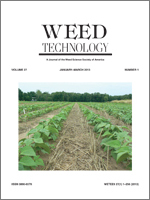A field experiment was conducted in Boone and Callaway counties in Missouri in 2010 and 2011 to investigate herbicide programs for the management of summer annual grass and broadleaf weeds in soybean resistant to 2,4-D and glufosinate. Results revealed that the addition of 0.56, 0.84, or 1.12 kg ha−1 2,4-D (amine) to either or both POST applications of glufosinate in a two-pass POST herbicide program increased control of common waterhemp compared to two POST applications of glufosinate alone. Similar levels of common cocklebur, giant foxtail, large crabgrass, and barnyardgrass control were achieved with any of the two-pass POST programs that contained 2,4-D compared to two-pass POST programs containing glufosinate alone. Similar control of these species was also achieved with the inclusion of 2,4-D in either the first or second pass of glufosinate. Two-pass programs resulted in the highest levels of weed control (90%). Annual grass and broadleaf weed control was as much as 59% lower when one-pass POST herbicide programs were compared to PRE followed by (fb) POST or two-pass POST programs. However, one-pass POST programs were sufficient to obtain exceptional control of common cocklebur and giant foxtail. Across all site years, soybean yields ranged from 2,680 to 3,100 kg ha−1 for all herbicide treatments, but did not differ statistically. Overall, results from these experiments indicate that compared to glufosinate alone, PRE fb POST or two-pass POST herbicide programs that incorporate 2,4-D amine with glufosinate in 2,4-D–resistant soybean enhance control of common waterhemp, while providing similar levels of control of other summer annual grass and broadleaf weeds.
Nomenclature: 2,4-D; glufosinate barnyardgrass, Echinochloa crus-galli (L.) Beauv. ECHCG; common cocklebur, Xanthium strumarium L. XANST; common waterhemp, Amarathus rudis Sauer AMATA; giant foxtail, Setaria faberi Herrm. SETFA; large crabgrass, Digitaria sanguinalis (L.) Scop. DIGSA; soybean, Glycine max (L.) Merr.
Se realizó un experimento de campo en los condados Boone y Callaway en Missouri en 2010 y 2011 para investigar programas de herbicidas para el manejo de malezas anuales de verano de hoja ancha y gramíneas en soya resistente a 2,4-D y glufosinate. Los resultados revelaron que la adición de 0.56, 0.84 ó 1.12 kg ha−1 2,4-D (amine) a cualquiera o ambas aplicaciones POST de glufosinate en un programa de herbicidas POST con dos pases incrementó el control de Amaranthus rudis comparado a dos aplicaciones POST de glufosinate solo. Niveles similares de control de Xanthium strumarium, Setaria faberi, Digitaria sanguinalis y Echinochloa crus-galli fueron alcanzados con cualquiera de los programas POST de dos pases que contenían 2,4-D al compararse con los programas POST de dos pases que contenían glufosinate solo. Un control similar de estas especies se alcanzó con la inclusión de 2,4-D en ya sea el primer o segundo pase con glufosinate. Los programas de dos pases resultaron en los niveles de control más altos (90%). El control de malezas anuales gramíneas y de hoja ancha fue hasta 59% menor cuando programas de herbicidas POST de un pase fueron comparados con programas PRE seguidos por (fb) POST o programas POST de dos pases. Sin embargo, programas POST de un pase fueron suficiente para obtener un control excepcional de X. strumarium y S. faberi. A través de todos los sitios-años, el rendimiento de la soya varió entre 2,680 y 3,100 kg ha−1 para todos los tratamientos con herbicidas, pero estos no difirieron estadísticamente. En





